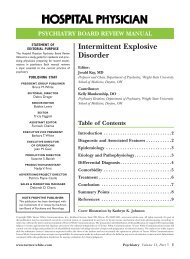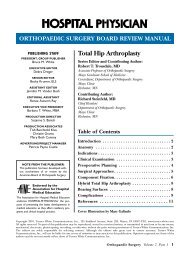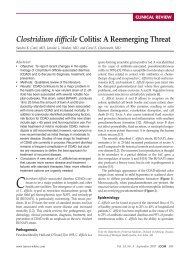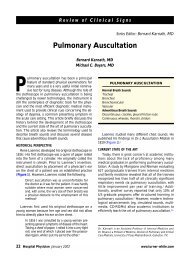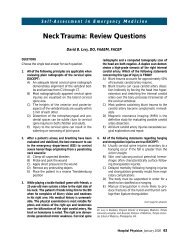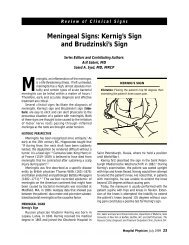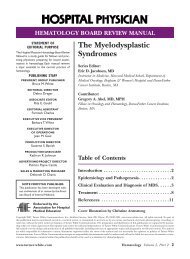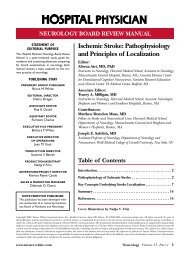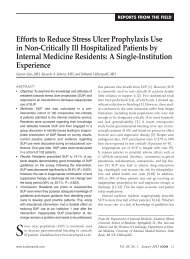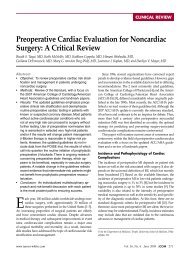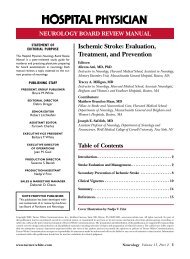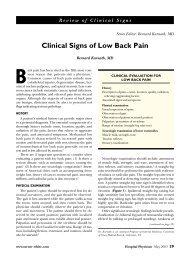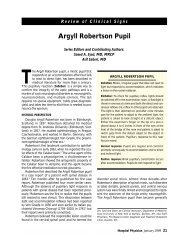approach to mediastinal masses - Turner White
approach to mediastinal masses - Turner White
approach to mediastinal masses - Turner White
You also want an ePaper? Increase the reach of your titles
YUMPU automatically turns print PDFs into web optimized ePapers that Google loves.
®<br />
pulmonary Disease Board Review Manual<br />
Statement of<br />
Edi<strong>to</strong>rial Purpose<br />
The Hospital Physician Pulmonary Disease Board<br />
Review Manual is a peer-reviewed study guide<br />
for fellows and practicing physicians preparing<br />
for board examinations in pulmonary disease.<br />
Each manual reviews a <strong>to</strong>pic essential <strong>to</strong> current<br />
practice in the subspecialty of pulmonary<br />
disease.<br />
PUBLISHING STAFF<br />
PRESIDENT, Group PUBLISHER<br />
Bruce M. <strong>White</strong><br />
edi<strong>to</strong>rial direc<strong>to</strong>r<br />
Debra Dreger<br />
Senior EDITOR<br />
Robert Litchkofski<br />
associate EDITOR<br />
Rita E. Gould<br />
assistant EDITOR<br />
Farrawh Charles<br />
executive vice president<br />
Barbara T. <strong>White</strong><br />
executive direc<strong>to</strong>r<br />
of operations<br />
Jean M. Gaul<br />
PRODUCTION Direc<strong>to</strong>r<br />
Suzanne S. Banish<br />
PRODUCTION associate<br />
Kathryn K. Johnson<br />
ADVERTISING/PROJECT Direc<strong>to</strong>r<br />
Patricia Payne Castle<br />
sales & marketing manager<br />
Deborah D. Chavis<br />
NOTE FROM THE PUBLISHER:<br />
This publication has been developed without<br />
involvement of or review by the American<br />
Board of Internal Medicine.<br />
Endorsed by the<br />
Association for Hospital<br />
Medical Education<br />
Approach <strong>to</strong> Mediastinal<br />
Masses<br />
Series Edi<strong>to</strong>r and Contribu<strong>to</strong>r:<br />
Gregory C. Kane, MD, FACP, FCCP<br />
Associate Professor, Division of Pulmonary and Critical Care Medicine<br />
Program Direc<strong>to</strong>r, Internal Medicine Residency, Jefferson Medical<br />
College, Philadelphia, PA<br />
Contribu<strong>to</strong>r:<br />
Francisco Aecio Almeida, Jr., MD<br />
Fellow, Division of Pulmonary and Critical Care Medicine, Thomas<br />
Jefferson University Hospital, Philadelphia, PA<br />
Table of Contents<br />
Introduction . . . . . . . . . . . . . . . . . . . . . . . . . . . . .2<br />
Ana<strong>to</strong>mic Considerations . . . . . . . . . . . . . . . . . . .2<br />
Approach <strong>to</strong> Evaluation . . . . . . . . . . . . . . . . . . . .2<br />
Middle Mediastinal Mass . . . . . . . . . . . . . . . . . . .3<br />
Anterior Mediastinal Mass . . . . . . . . . . . . . . . . . .6<br />
Posterior Mediastinal Mass . . . . . . . . . . . . . . . . . .9<br />
Conclusion . . . . . . . . . . . . . . . . . . . . . . . . . . . . .10<br />
References . . . . . . . . . . . . . . . . . . . . . . . . . . . . .10<br />
Cover Illustration by Catherine Twomey<br />
Copyright 2007, <strong>Turner</strong> <strong>White</strong> Communications, Inc., Strafford Avenue, Suite 220, Wayne, PA 19087-3391, www.turner-white.com. All rights reserved. No part of this<br />
publication may be reproduced, s<strong>to</strong>red in a retrieval system, or transmitted in any form or by any means, mechanical, electronic, pho<strong>to</strong>copying, recording, or otherwise,<br />
without the prior written permission of <strong>Turner</strong> <strong>White</strong> Communications. The preparation and distribution of this publication are supported by sponsorship<br />
subject <strong>to</strong> written agreements that stipulate and ensure the edi<strong>to</strong>rial independence of <strong>Turner</strong> <strong>White</strong> Communications. <strong>Turner</strong> <strong>White</strong> Communications retains full<br />
control over the design and production of all published materials, including selection of <strong>to</strong>pics and preparation of edi<strong>to</strong>rial content. The authors are solely responsible<br />
for substantive content. Statements expressed reflect the views of the authors and not necessarily the opinions or policies of <strong>Turner</strong> <strong>White</strong> Communications.<br />
<strong>Turner</strong> <strong>White</strong> Communications accepts no responsibility for statements made by authors and will not be liable for any errors of omission or inaccuracies. Information<br />
contained within this publication should not be used as a substitute for clinical judgment.<br />
www.turner-white.com<br />
pulmonary Disease Volume 12, Part 2
Pulmonary Disease Board Review Manual<br />
Approach <strong>to</strong> Mediastinal Masses<br />
Francisco Aecio Almeida, Jr., MD, and Gregory C. Kane, MD, FACP, FCCP<br />
INTRODUCTION<br />
Mediastinal <strong>masses</strong> affect patients of all ages and can<br />
be asymp<strong>to</strong>matic. In fact, only approximately one third<br />
of <strong>mediastinal</strong> tumors cause symp<strong>to</strong>ms. 1 Consequently,<br />
a <strong>mediastinal</strong> mass is frequently first noted on a routine<br />
chest radiograph, although the plain radiograph<br />
is rarely diagnostic. When symp<strong>to</strong>ms develop, patients<br />
can present with complaints related <strong>to</strong> compression of<br />
vital structures (eg, cough or wheezing from bronchial<br />
compression, dysphagia from esophageal compression,<br />
superior vena cava syndrome from compression); pain<br />
from involvement of bone, pleura, or pericardium; diaphragmatic<br />
paralysis or vocal cord paralysis due <strong>to</strong> involvement<br />
of the phrenic nerves or recurrent laryngeal<br />
nerves, respectively; limb paralysis due <strong>to</strong> involvement<br />
of the spinal column; or constitutional complaints.<br />
Both localized disorders (eg, primary tumors or cysts)<br />
and systemic diseases, including metastatic neoplasms<br />
and granulomas, can be responsible for <strong>mediastinal</strong><br />
<strong>masses</strong>.<br />
Although several techniques for obtaining tissue<br />
for the diagnosis of <strong>mediastinal</strong> <strong>masses</strong> are available,<br />
neither guidelines nor a standard of care <strong>approach</strong><br />
<strong>to</strong> evaluating these <strong>masses</strong> has been developed. Due<br />
<strong>to</strong> the diversity of the structures within the mediastinum,<br />
the wide variety of his<strong>to</strong>logic types of <strong>mediastinal</strong><br />
<strong>masses</strong>, and the relative difficulty in gaining access for<br />
diagnostic examination, <strong>masses</strong> in the mediastinum<br />
can present a diagnostic and management challenge.<br />
In this manual, we review the diagnostic entities <strong>to</strong> be<br />
considered and typical diagnostic <strong>approach</strong>es used in<br />
patients who present with <strong>mediastinal</strong> <strong>masses</strong>.<br />
ANATOMIC CONSIDERATIONS<br />
The mediastinum is located in the center of the<br />
thorax between the 2 pleural cavities, the diaphragm<br />
and the thoracic inlet. 2 Although various divisions of<br />
the mediastinum exist, most clinicians use Fraser et al’s<br />
classification in which the mediastinum as visualized<br />
on a lateral radiograph is divided in<strong>to</strong> anterior, middle,<br />
www.turner-white.com<br />
Hospital Physician Board Review Manual<br />
and posterior compartments (Figure 1). 3 The anterior<br />
<strong>mediastinal</strong> compartment is bounded anteriorly<br />
by the sternum and posteriorly by the pericardium,<br />
aorta, and brachiocephalic vessels. The compartment<br />
contains the thymus gland, branches of the internal<br />
mammary artery and vein, lymph nodes, the inferior<br />
sternopericardial ligament, and variable amounts of<br />
fat. 4 The middle <strong>mediastinal</strong> compartment contains<br />
the pericardium and its contents, the ascending aorta<br />
and the aortic arch, the superior and inferior vena cava,<br />
the brachiocephalic (innominate) arteries and veins,<br />
the phrenic nerves and cephalad portion of the vagus<br />
nerves, the trachea and main bronchi and their regional<br />
lymph nodes, and the pulmonary arteries and veins. 4<br />
The posterior <strong>mediastinal</strong> compartment is bounded<br />
anteriorly by the pericardium and the vertical part of<br />
the diaphragm, laterally by the <strong>mediastinal</strong> pleura, and<br />
posteriorly by the bodies of the thoracic vertebrae. It<br />
contains the descending thoracic aorta, esophagus,<br />
thoracic duct, azygos and hemiazygos veins, au<strong>to</strong>nomic<br />
nerves, fat, and lymph nodes. 4<br />
When formulating the differential diagnosis of a<br />
<strong>mediastinal</strong> mass, the location of the mass should be<br />
considered because some disorders occur characteristically<br />
in certain compartments (Table 1).<br />
APPROACH TO EVALUATION<br />
The diagnosis of <strong>mediastinal</strong> disorders may be<br />
<strong>approach</strong>ed in 2 phases: noninvasive imaging techniques<br />
and invasive procedures for tissue sampling. 5<br />
All patients should have a detailed his<strong>to</strong>ry and physical<br />
examination before a major work-up is initiated. Symp<strong>to</strong>ms<br />
or signs of myasthenia gravis may obviate the need<br />
for preliminary biopsy, and patients with these findings<br />
can be referred for excision of the mass. A palpable<br />
superficial lymph node may suggest a metastatic disease<br />
or lymphoma, again obviating the need for sampling<br />
the <strong>mediastinal</strong> mass. A palpable thyroid may suggest<br />
<strong>mediastinal</strong> extension of a cervical goiter. A testicular<br />
examination should be done in all male patients with<br />
an anterior <strong>mediastinal</strong> mass. If there is any doubt<br />
whether a mass is present, ultrasound evaluation of the<br />
pulmonary Disease www.turner-white.com<br />
Volume 12, Part 2
A p p r o a c h t o M e d i a s t i n a l M a s s e s<br />
scrotum should be performed before invasive tests in<br />
the chest are performed.<br />
Most <strong>mediastinal</strong> abnormalities are first detected<br />
by standard posteroanterior and lateral chest radiographs.<br />
5 Whenever a <strong>mediastinal</strong> mass is detected on<br />
plain films, a computed <strong>to</strong>mography (CT) scan of<br />
the chest is generally indicated. Most patients with a<br />
<strong>mediastinal</strong> mass who present <strong>to</strong> a pulmonologist will<br />
likely already have had a CT scan of the chest. We recommend<br />
that a CT scan of the chest with intravenous<br />
contrast media be obtained in those who have not had<br />
a scan. Although some centers use intravenous contrast<br />
routinely <strong>to</strong> evaluate the mediastinum, it is only required<br />
for optimal evaluation of the hila. 6 Demonstration<br />
of the status of the intrathoracic blood vessels is<br />
the major indication for magnetic resonance imaging<br />
(MRI) of the mediastinum. 6 Also, MRI provides better<br />
soft tissue differentiation than CT, and therefore it may<br />
offer better characterization of cysts and adenomas<br />
(Table 2). MRI should be considered in patients who<br />
cannot receive iodinated intravenous contrast.<br />
In most patients with a <strong>mediastinal</strong> mass, an invasive<br />
procedure is required <strong>to</strong> obtain a diagnostic tissue sample<br />
(Table 3). Tissue sampling is always necessary in patients<br />
with suspected lymphoma (which can occur in any<br />
<strong>mediastinal</strong> compartment), lymphadenopathy (which<br />
would suggest metastatic disease or lymphoma), or positive<br />
serologic tests for α-fe<strong>to</strong>protein (AFP) or β-human<br />
chorionic gonadotropin (β-HCG, which would suggest<br />
nonseminoma<strong>to</strong>us malignant germ cell tumors). If lymphoma<br />
is an important differential diagnosis, a definitive<br />
biopsy (not fine-needle aspiration or core needle biopsy)<br />
generally should be performed. Patient characteristics<br />
(eg, performance status, age) must be considered when<br />
deciding how invasive the biopsy <strong>approach</strong> will be. If<br />
fine-needle aspiration and/or core needle biopsy are<br />
<strong>to</strong> be attempted, we favor either transbronchial biopsy,<br />
ideally utilizing endobronchial ultrasound (EBUS),<br />
or CT-guided biopsy based on proximity. Endoscopic<br />
ultrasonography-guided biopsy should be considered,<br />
also based on proximity <strong>to</strong> the esophagus, in centers<br />
where there is experience with this procedure.<br />
middle Mediastinal Mass<br />
Case Presentation 1<br />
A 25-year-old woman presents with a complaint of<br />
heartburn, dysphagia, and mid-chest discomfort of<br />
3 weeks’ duration. She has not experienced fever, chills,<br />
Figure 1. Lateral chest radiograph showing the mediastinum<br />
divided in<strong>to</strong> anterior (A), middle (M), and posterior (P) compartments.<br />
(Adapted from Park DR, Pierson DJ. Disorders of the<br />
mediastinum: general principles and diagnostic <strong>approach</strong>. In: Murray<br />
JF, Nadel JA, edi<strong>to</strong>rs. Textbook of respira<strong>to</strong>ry medicine. 3rd ed.<br />
Philadelphia: W.B. Saunders; 2000:2080. Copyright © 2000, with<br />
permission from Elsevier.)<br />
night sweats, or significant weight loss. The patient is<br />
a native of India and immigrated <strong>to</strong> the United States<br />
at 11 years of age. She has never smoked. Eight years<br />
prior <strong>to</strong> presentation, she had a nonreactive tuberculin<br />
skin test using purified protein derivative (PPD). Physical<br />
examination reveals normal vital signs, no palpable<br />
lymph nodes, and clear lungs on auscultation.<br />
An initial portable anteroposterior radiograph is<br />
normal. A barium swallow examination demonstrates<br />
a focal ulceration of the mid portion of the esophagus<br />
without perforation. Esophagogastroduodenoscopy<br />
(EGD) demonstrates an esophageal ulceration with<br />
fistula formation. A chest CT scan with intravenous contrast<br />
is obtained <strong>to</strong> further evaluate for involvement of<br />
adjacent organs and reveals a 2.3 × 3.4 × 5.0 cm enhancing<br />
subcarinal mass inseparable from the esophagus<br />
(Figure 2;see page 6) as well as compression of the right<br />
pulmonary artery.<br />
• What diagnoses should be considered when evaluating<br />
a middle <strong>mediastinal</strong> mass?<br />
Hospital Physician Board Review Manual<br />
www.turner-white.com
A p p r o a c h t o M e d i a s t i n a l M a s s e s<br />
Table 1. Differential Diagnosis of Mediastinal Mass by Compartment<br />
Anterior Mediastinum Middle Mediastinum Posterior Mediastinum<br />
Thymic diseases: thymoma, thymic carcinoma, thymic<br />
carcinoid, thymolipoma, non-neoplastic thymic cysts<br />
Germ cell tumors: seminoma, nonseminoma<strong>to</strong>us germ cell<br />
tumors (embryonal cell carcinoma, choriocarcinoma)<br />
Lymphoma: Hodgkin’s disease, non-Hodgkin’s lymphoma<br />
Thyroid neoplasms<br />
Parathyroid neoplasms<br />
Mesenchymal tumors: lipoma, fibroma, lymphangioma,<br />
hemangioma, mesothelioma, others<br />
Diaphragmatic hernia (Morgagni)<br />
Primary carcinoma<br />
Angiofollicular lymphoid hyperplasia (Castleman’s disease)<br />
Lymphadenopathy: reactive and granuloma<strong>to</strong>us<br />
inflammation (eg, tuberculosis or<br />
fungal diseases, metastasis)<br />
Lymphoma: Hodgkin’s disease, non-<br />
Hodgkin’s lymphoma<br />
Developmental cysts: pericardial cyst,<br />
foregut duplication cysts (bronchogenic<br />
cyst, enteric cyst), others<br />
Vascular enlargements<br />
Diaphragmatic hernia (hiatal)<br />
Neurogenic tumors arising from<br />
peripheral nerves, sympathetic<br />
ganglia, or paraganglionic tissue<br />
Meningocele<br />
Esophageal lesions: carcinoma,<br />
diverticula<br />
Diaphragmatic hernia (Bochdalek)<br />
Miscellaneous<br />
Adapted from Park DR, Pierson DJ. Disorders of the mediastinum: general principles and diagnostic <strong>approach</strong>. In: Murray JF, Nadel JA, edi<strong>to</strong>rs.<br />
Textbook of respira<strong>to</strong>ry medicine. 3rd ed. Philadelphia: W.B. Saunders; 2000:2081. Copyright © 2000, with permission from Elsevier.<br />
Differential Diagnosis<br />
Lymphomas<br />
The differential diagnosis of a middle <strong>mediastinal</strong><br />
mass is summarized in Table 1. Lymphoma is one of<br />
the most common <strong>mediastinal</strong> tumors, representing<br />
10% <strong>to</strong> 15% of all <strong>mediastinal</strong> <strong>masses</strong>, 7,8 and presents<br />
more frequently as a generalized disease, although it<br />
may manifest as a primary <strong>mediastinal</strong> disease. 9–11 In<br />
patients with peripheral lymphoma and <strong>mediastinal</strong><br />
involvement, 50% <strong>to</strong> 70% have Hodgkin’s disease<br />
(HD) and 15% <strong>to</strong> 25% have non-Hodgkin’s lymphoma<br />
(NHL). 9,12 Subtypes of HD include nodular sclerosis<br />
(the most common subtype), 10 mixed cellularity,<br />
lymphocyte depletion, lymphocyte-rich classical, and<br />
nodular lymphocyte predominant. Nodular sclerosis<br />
HD has a predilection for the anterior mediastinum,<br />
especially the thymus. 9,10,13 Only 20% <strong>to</strong> 30% of patients<br />
with HD present with fever, night sweats, and/or weight<br />
loss. 14 Although HD may present with cough, wheezing,<br />
chest pain, and/or dysphagia due <strong>to</strong> invasion of or<br />
mass effect on <strong>mediastinal</strong> structures, up <strong>to</strong> 55% of patients<br />
may be asymp<strong>to</strong>matic, and these <strong>masses</strong> may be<br />
incidentally noted on radiographs obtained for other<br />
reasons. 10 Large B-cell lymphoma and lymphoblastic<br />
lymphoma (variants of NHL) also have a predilection<br />
for the anterior mediastinum and are the most common<br />
primary <strong>mediastinal</strong> NHL. 9,12<br />
Tuberculosis and Other Granuloma<strong>to</strong>us Disorders<br />
Tuberculous lymphadenitis is another important consideration<br />
in this patient. Tuberculosis (TB) is responsible<br />
for up <strong>to</strong> 43% of all of peripheral lymphadenopathy<br />
in the developing world. 15 In the United States, 5.4%<br />
www.turner-white.com<br />
of all TB cases are extrapulmonary, and 31% of these<br />
are lymphatic. 16 In developed countries, 70% <strong>to</strong> 85% of<br />
patients with TB lymphadenitis are immigrants. The cervical<br />
region is most frequently involved, but <strong>mediastinal</strong><br />
involvement occurs in approximately 27% of cases. 17 Although<br />
some suggest that an isolated chronic nontender<br />
lymphadenopathy in a young adult without systemic<br />
symp<strong>to</strong>ms is the most common presentation of tuberculous<br />
lymphadenitis, 18 a series of 61 patients found that<br />
all patients had night sweats, weight loss, and weakness. 17<br />
In this same series, except for one HIV-positive patient,<br />
all patients had a positive PPD test. Most HIV-negative<br />
patients with tuberculous lymphadenitis have an unremarkable<br />
chest radiograph. 17,19 Tuberculous <strong>mediastinal</strong><br />
lymphadenopathy presenting with dysphagia 20 or esophageal<br />
perforation 21 has been reported.<br />
In patients with granuloma<strong>to</strong>us mediastinitis secondary<br />
<strong>to</strong> his<strong>to</strong>plasmosis, symp<strong>to</strong>ms that include chest<br />
pain, cough, hemoptysis, and dyspnea may be caused<br />
by compression of the airways, superior vena cava, or<br />
pulmonary vessels. 22 Involvement of the esophagus may<br />
result in dysphagia, odynophagia, or chest pain but<br />
only occasionally leads <strong>to</strong> the development of bronchoesophageal<br />
or tracheoesophageal fistulas. 23,24<br />
Developmental Cysts<br />
Mediastinal cysts account for 18% of <strong>mediastinal</strong><br />
<strong>masses</strong>. 25 Foregut duplication cysts, which are frequently<br />
the reference for bronchogenic and enteric cysts, are<br />
typically found near the large airways, often just posterior<br />
<strong>to</strong> the carina. 5 Bronchogenic cysts affect adults in<br />
their mid-thirties (mean age, 36 years), while enteric<br />
cysts are relatively uncommon in adults but are the<br />
pulmonary Disease Volume 12, Part 2
A p p r o a c h t o M e d i a s t i n a l M a s s e s<br />
Table 2. Comparison of Computed Tomography and Magnetic Resonance Imaging in the Evaluation of Mediastinal Masses<br />
CT Superior MRI Superior CT and MRI Equivalent<br />
Spatial resolution<br />
Detection of calcification<br />
Detection of bony destruction<br />
Detection of lung nodules<br />
Evaluation of lung parenchyma<br />
Single study screening for lung, liver, and<br />
adrenal metastases<br />
Multiplanar imaging capability<br />
No intravenous contrast needed<br />
Potential for cardiac gating<br />
Identification of complex fluid collections<br />
Soft tissue differentiation: tumor versus fibrosis, tumor<br />
versus pos<strong>to</strong>bstructive pneumonitis<br />
Evaluation of brachial plexus, neural foramina, diaphragm,<br />
bone marrow, <strong>mediastinal</strong> tissue invasion<br />
Detection of pure fluid collections<br />
Detection of chest wall invasion<br />
Evaluation of vascular obstruction<br />
(contrast CT)<br />
Adapted from Moore EH. Radiologic evaluation of <strong>mediastinal</strong> <strong>masses</strong>. Chest Surg Clin N Am 1992;2:9. Copyright © 1992, with permission from<br />
Elsevier.<br />
CT = computed <strong>to</strong>mography; MRI = magnetic resonance imaging.<br />
most common cysts found in infants and children. 5 Two<br />
thirds of patients with developmental cysts eventually<br />
develop local symp<strong>to</strong>ms. 25 Bronchogenic cysts generally<br />
present as a well-circumscribed mass without significant<br />
compressive effects and with variable CT density of its<br />
contents and a smooth, thin wall 27 ; therefore, it is an<br />
unlikely diagnosis for this patient.<br />
• What diagnostic testing is appropriate in this patient?<br />
DIAGNOSTIC TESTING<br />
Lymphoma is one of the leading differential diagnoses<br />
in this case, and fine-needle aspiration or core<br />
needle biopsy do not consistently provide sufficient<br />
tissue for his<strong>to</strong>logic, immunologic, and molecular biologic<br />
assessment of this disease. 28 Therefore, a surgical<br />
<strong>approach</strong> is appropriate for this patient.<br />
Table 3. Techniques for Obtaining Mediastinal Tissue<br />
Surgical excision<br />
Video-assisted thoracoscopic surgery<br />
Thoraco<strong>to</strong>my<br />
Anterior mediastino<strong>to</strong>my (Chamberlain’s procedure): for lesions in<br />
left hila or aor<strong>to</strong>pulmonary window<br />
Mediastinoscopy<br />
Needle aspiration and core biopsy<br />
Transbronchial via a fiberoptic bronchoscope<br />
Percutaneous (computed <strong>to</strong>mography or ultrasonography guided)<br />
Endoscopic ultrasonography guided<br />
CASE 1: Further evaluation<br />
A biopsy via cervical mediastinoscopy is performed,<br />
and the specimen demonstrates granuloma<strong>to</strong>us inflammation<br />
with foci of caseation (Figure 3 and Figure 4).<br />
Special stains for fungus and mycobacterium are negative.<br />
Following this procedure, a PPD tuberculosis test<br />
is placed and is reactive (22 mm). A presumptive diagnosis<br />
of tuberculous lymphadenitis is made.<br />
• Could this mass have been <strong>approach</strong>ed in a different<br />
way?<br />
Retrospectively, a tuberculin skin test could have<br />
been performed before any invasive procedures were<br />
performed, especially if the patient’s immigration status<br />
had been taken in<strong>to</strong> account. Most HIV-seronegative<br />
patients (this patient eventually tested negative for HIV<br />
infection) with tuberculous lymphadenitis are PPD positive.<br />
17–19 If this path had been chosen, one might have<br />
considered doing a bronchoscopy with transbronchial<br />
needle biopsy and aspiration before a mediastinoscopy<br />
because most patients with tuberculous lymphadenitis<br />
can be diagnosed with these procedures. 17,29,30 Also,<br />
isolation of Mycobacterium tuberculosis is not necessary <strong>to</strong><br />
make a diagnosis of tuberculous lymphadenitis because<br />
less than 50% of patients with this disorder have positive<br />
cultures. 17 However, M. tuberculosis grew in this patient’s<br />
tissue culture after 4 weeks. In centers where pulmonologists<br />
feel comfortable doing transbronchial needle<br />
biopsy and aspiration, this path likely would have been<br />
taken. EBUS has the capability of visualizing the layers<br />
of the bronchial mucosa and can differentiate with<br />
reliability neighboring tumors or <strong>masses</strong>, lymph nodes,<br />
and vascular structures. 31 In addition, EBUS-guided<br />
lymph node sampling has been shown <strong>to</strong> be superior <strong>to</strong><br />
standard aspiration in all locations except the subcarinal<br />
region. 32 EBUS-guided transbronchial fine-needle<br />
aspiration should be used where available <strong>to</strong> sample<br />
<strong>masses</strong> near <strong>to</strong> the tracheobronchial tree. In this case,<br />
Hospital Physician Board Review Manual<br />
www.turner-white.com
A p p r o a c h t o M e d i a s t i n a l M a s s e s<br />
Figure 2. Computed <strong>to</strong>mography scan of case patient 1 showing<br />
a subcarinal mass that is inseparable from the esophagus (solid<br />
arrow). The mass also demonstrates irregular enhancement with a<br />
central area of probable necrosis (dashed arrow).<br />
Figure 4. Pho<strong>to</strong>micrograph of a specimen of the subcarinal<br />
<strong>mediastinal</strong> mass from case patient 1. A large area of necrosis is<br />
surrounded by a granuloma<strong>to</strong>us chronic inflamma<strong>to</strong>ry infiltrate.<br />
Note the prominent giant cell (arrow) (hema<strong>to</strong>xylin and eosinstained,<br />
20×).<br />
A 34-year-old African-American man with mild hypertension<br />
presents <strong>to</strong> the emergency department with acuteonset<br />
chest pain that began several hours prior <strong>to</strong> presentation.<br />
He has no cough, dyspnea, fever, chills, night<br />
sweats, or weight loss. He is a lifelong nonsmoker. Physical<br />
examination reveals normal vital signs, no palpable<br />
lymph nodes, and clear lungs on auscultation.<br />
An initial chest radiograph is normal. A CT angiogram<br />
of the chest does not demonstrate pulmonary<br />
embolism but does show a large anterior <strong>mediastinal</strong><br />
mass (Figure 5).<br />
• What diagnoses should be considered when evaluating<br />
an anterior <strong>mediastinal</strong> mass?<br />
Figure 3. Pho<strong>to</strong>micrograph of a specimen of the subcarinal <strong>mediastinal</strong><br />
mass from case patient 1. A single granuloma demonstrates<br />
central necrosis with surrounding palisaded epithelioid macrophages<br />
(hema<strong>to</strong>xylin and eosin-stained, 20×).<br />
EBUS was probably not appropriate due <strong>to</strong> the subcarinal<br />
location of the mass. Alternatively, endoscopic<br />
ultrasound-guided fine-needle aspiration biopsy has<br />
shown promise in the diagnosis of <strong>mediastinal</strong> lesions<br />
located near the esophagus. 33,34<br />
anterior <strong>mediastinal</strong> mass<br />
Case Presentation 2<br />
www.turner-white.com<br />
DIFFERENTIAL DIAGNOSIS<br />
Thymic Neoplasms<br />
The differential diagnosis of an anterior <strong>mediastinal</strong><br />
mass is summarized in Table 1. Thymic tumors are the<br />
most common primary tumors of the anterior mediastinum,<br />
constituting 30% <strong>to</strong> 50% of all the <strong>masses</strong> in<br />
this location; thymomas are responsible for most of<br />
these. 8,35–37 Most patients are adults older than 40 years,<br />
with equal sex predilection. 35,36 Approximately 50% of<br />
patients with thymoma are asymp<strong>to</strong>matic at the time<br />
of diagnosis. 38,39 At diagnosis, symp<strong>to</strong>ms due <strong>to</strong> tumorrelated<br />
syndromes or, more commonly, myasthenia<br />
gravis are present in up <strong>to</strong> one half of patients. 40,41<br />
Conversely, only 15% of patients with myasthenia gravis<br />
have a thymoma. 42 All patients suspected <strong>to</strong> have thymoma,<br />
even if they are asymp<strong>to</strong>matic, should have a<br />
serum antiacetylcholine (Ach) recep<strong>to</strong>r antibody level<br />
examined <strong>to</strong> exclude myasthenia gravis. 43,44<br />
Most thymomas arise in the upper anterior mediastinum<br />
but may project in<strong>to</strong> the adjacent middle or<br />
pulmonary Disease Volume 12, Part 2
A p p r o a c h t o M e d i a s t i n a l M a s s e s<br />
Figure 5. Computed <strong>to</strong>mography scan of case patient 2 showing<br />
the large anterior <strong>mediastinal</strong> mass (straight arrow) and adenopathy<br />
(curved arrow).<br />
Figure 6. Pho<strong>to</strong>micrograph of a sample from the anterior <strong>mediastinal</strong><br />
mass in case patient 2. Prominent fibrous bands surround<br />
nodules of lymphoid tissue, a pattern characteristic of nodular<br />
sclerosis Hodgkin’s disease (hema<strong>to</strong>xylin and eosin-stained, 20×).<br />
posterior mediastinum. 6 They vary in size from very<br />
small <strong>to</strong> larger than 20 cm in diameter. Thymomas are<br />
typically found just anterior <strong>to</strong> the aortic root, 36 above<br />
the right ventricular outflow tract and the main pulmonary<br />
artery, and project in<strong>to</strong> one side of the midline. 6<br />
Thymomas are usually well-defined, with spherical or<br />
lobulated borders. 45 Only the larger tumors are visible<br />
on plain radiograph. 6 On CT, encapsulated thymomas<br />
can appear as a homogeneous or heterogeneous softtissue<br />
mass, depending on the presence of hemorrhage,<br />
necrosis, or cyst formation. 45 It is not possible <strong>to</strong><br />
distinguish encapsulated from invasive thymomas until<br />
<strong>mediastinal</strong> invasion has occurred. 6 Other thymic neoplasms<br />
include thymic carcinoma, thymic carcinoid,<br />
and thymolipoma; the last 2 are very rare. Thymic<br />
carcinomas often manifest as large, poorly defined,<br />
infiltrative anterior <strong>mediastinal</strong> <strong>masses</strong> that can exhibit<br />
cystic changes like thymomas. 46 However, these carcinomas<br />
frequently metastasize <strong>to</strong> regional lymph nodes<br />
and distant sites. 47,48<br />
Germ Cell Tumors<br />
The anterior mediastinum is the most common<br />
extragonadal primary site of <strong>mediastinal</strong> germ cell tumors.<br />
49,50 These tumors account for 15% of anterior<br />
<strong>mediastinal</strong> tumors in adults aged 20 <strong>to</strong> 40 years and<br />
for 24% of tumors in children. 7,50,51 Tera<strong>to</strong>mas are the<br />
most common <strong>mediastinal</strong> germ cell tumors, 49,50 and<br />
they contain varying amounts of tissues derived from<br />
at least 2 of the 3 primitive germ layers: ec<strong>to</strong>derm<br />
(skin, hair, sweat glands, sebaceous material, or <strong>to</strong>othlike<br />
structures), endoderm (respira<strong>to</strong>ry or intestinal<br />
Figure 7. A higher-power pho<strong>to</strong>micrograph of a sample from<br />
the anterior <strong>mediastinal</strong> mass in case patient 2. A binucleated<br />
Reed-Sternberg cell (arrow) with prominent eosinophilic nucleoli<br />
is surrounded by reactive lymphocytes (hema<strong>to</strong>xylin and eosinstained,<br />
60×).<br />
epithelium, or pancreatic tissue), and mesoderm (fat,<br />
cartilage, bone, or smooth muscle). 50,52,53 Most tera<strong>to</strong>mas<br />
are mature, without evidence of poorly differentiated or<br />
immature elements, and have little or no malignant potential.<br />
50 Patients are usually asymp<strong>to</strong>matic. 52 Although<br />
rare, expec<strong>to</strong>ration of hair (trichoptysis) or sebaceous<br />
debris is a pathognomonic sign of ruptured <strong>mediastinal</strong><br />
tera<strong>to</strong>ma. 52,54 Rupture of the tera<strong>to</strong>ma in<strong>to</strong> the bronchi,<br />
pleura, pericardium, or lung can be precipitated by digestive<br />
enzymes secreted by intestinal mucosa or pancreatic<br />
tissue in the tumor. 49,52,54 On chest radiograph, these<br />
tumors are rounded <strong>to</strong> lobulated, well-circumscribed<br />
Hospital Physician Board Review Manual<br />
www.turner-white.com
A p p r o a c h t o M e d i a s t i n a l M a s s e s<br />
anterior <strong>mediastinal</strong> <strong>masses</strong> that often protrude in<strong>to</strong> one<br />
lung field. 52 On CT, <strong>mediastinal</strong> mature tera<strong>to</strong>ma typically<br />
manifests as a heterogeneous anterior <strong>mediastinal</strong><br />
mass with soft-tissue, fluid, fat, or calcium attenuation,<br />
or any combination of these findings. Fluid-containing<br />
cystic areas, fat, and calcification occur frequently. The<br />
findings of fat and fluid levels produced by high lipid<br />
content in the cyst fluid are diagnostic for tera<strong>to</strong>ma but<br />
are rare. 55,56<br />
Although primary <strong>mediastinal</strong> seminomas are uncommon,<br />
representing only 2% <strong>to</strong> 4% of all <strong>mediastinal</strong><br />
<strong>masses</strong>, they account for 25% <strong>to</strong> 50% of malignant<br />
<strong>mediastinal</strong> germ cell tumors of single his<strong>to</strong>logy. 57–59<br />
Most patients are in their third and fourth decades, and<br />
about 30% are asymp<strong>to</strong>matic at the time of initial diagnosis.<br />
58 On radiologic imaging, seminomas manifest as<br />
a bulky lobulated homogeneous anterior <strong>mediastinal</strong><br />
mass, 57 infrequently invading adjacent structures. 49,60<br />
Choriocarcinomas, embryonal carcinomas, endodermal<br />
sinus tumors, tera<strong>to</strong>carcinomas, and malignant<br />
tera<strong>to</strong>mas are commonly grouped <strong>to</strong>gether as malignant<br />
germ cell tumors that are not pure seminomas.<br />
These rare malignant tumors are found in the anterior<br />
mediastinum, often in association with the thymus, and<br />
typically cause symp<strong>to</strong>ms in young men. 49,61 Radiologically,<br />
these are large, irregular <strong>masses</strong>, frequently with<br />
significant heterogeneous areas of low attenuation<br />
due <strong>to</strong> necrosis, hemorrhage, and/or cyst formation. 60<br />
Pleural and pericardial effusions are commonly present.<br />
49,60<br />
Lymphomas<br />
Patients with HD typically present with cervical or<br />
supraclavicular lymphadenopathy. 9 Patients with HD<br />
who present with <strong>mediastinal</strong> involvement are usually<br />
younger than those who present without <strong>mediastinal</strong><br />
disease (29 years versus 38 years). 62 Most patients with<br />
HD who have an abnormal chest radiograph have bilateral<br />
asymmetric nodal disease. 63 The prevascular and<br />
paratracheal nodes are the most commonly affected<br />
nodes, 64 and only 15% of patients with intrathoracic<br />
HD have enlargement of a single lymph node group. 13<br />
Bulky nodal <strong>mediastinal</strong> disease can be caused by both<br />
HD and NHL. 9,65 NHL involves the anterior mediastinum<br />
less frequently than HD. 14 Also, NHL has a greater<br />
tendency <strong>to</strong> noncontiguously spread <strong>to</strong> the middle and<br />
posterior mediastinum. 13,66<br />
Goiter<br />
Despite the frequency of goiter, <strong>mediastinal</strong> goiter<br />
represents only 10% of <strong>mediastinal</strong> <strong>masses</strong> in surgical<br />
series. 2 Cervical goiters may descend in<strong>to</strong> the thorax in<br />
www.turner-white.com<br />
5% <strong>to</strong> 24% of cases, 2,67 generally in<strong>to</strong> the left anterior<br />
superior mediastinum. 68 Primary intrathoracic thyroid<br />
mass, either benign or malignant, developing from hetero<strong>to</strong>pic<br />
tissue is extremely unusual. 2,69,70 In a study of patients<br />
with a substernal goiter, the most common symp<strong>to</strong>ms<br />
were cervical mass (69%), dysphagia (33%), and<br />
dyspnea (28%); 13% of patients were asymp<strong>to</strong>matic. 71<br />
Most patients with a substernal goiter have a palpable<br />
cervical mass (goiter) on examination. Radiologically,<br />
<strong>mediastinal</strong> goiter is an encapsulated, lobulated, heterogeneous<br />
tumor. 72 The diagnostic radiologic feature is the<br />
clear continuity with the cervical thyroid gland. 68<br />
Parathyroid Adenoma<br />
Only 10% of parathyroid adenomas are ec<strong>to</strong>pic, and<br />
almost half occur in the anterior mediastinum, 73,74 usually<br />
near or within the thymus. 75 They are encapsulated<br />
and rounded, usually measuring less than 3 cm, and on<br />
CT they may resemble a lymph node. 73,74<br />
• Considering the above differential diagnoses, how<br />
should this mass be <strong>approach</strong>ed?<br />
Diagnostic testing<br />
As in case 1, this patient’s <strong>mediastinal</strong> disease was not<br />
detected on the chest radiograph. The CT scan, however,<br />
clearly demonstrated the presence of the mass in the<br />
anterior mediastinum. Based on the differential diagnosis,<br />
malignancy appears <strong>to</strong> be of greatest concern. Indeed,<br />
anterior <strong>mediastinal</strong> <strong>masses</strong> are more likely <strong>to</strong> be<br />
malignant than <strong>masses</strong> found in the other <strong>mediastinal</strong><br />
compartments. In one series of 400 patients with cysts<br />
and neoplasms of the mediastinum, 59% of anterior<br />
<strong>masses</strong> were malignant, versus 29% and 16% of middle<br />
and posterior <strong>mediastinal</strong> <strong>masses</strong>, respectively. 8 This<br />
patient’s current CT excludes mature tera<strong>to</strong>ma, <strong>mediastinal</strong><br />
goiter, and parathyroid adenoma with confidence.<br />
The causes of anterior <strong>mediastinal</strong> <strong>masses</strong> presented in<br />
Table 1 but not discussed above are very rare; thus, the<br />
leading differential diagnoses at this point should be<br />
lymphoma, thymoma, and germ cell tumors.<br />
Serologic evaluation for Ach recep<strong>to</strong>r antibodies,<br />
AFP, and β-HCG should be performed <strong>to</strong> exclude<br />
myasthenia gravis and nonseminoma<strong>to</strong>us malignant<br />
germ cell tumors. 75 However, lack of myasthenia gravis<br />
does not rule out thymoma. Also, this patient’s mass is<br />
located just anterior <strong>to</strong> the aortic root, the most common<br />
location of thymomas. Complete surgical resection<br />
is the mainstay of therapy for thymomas. 76,77 Often,<br />
patients with primary <strong>mediastinal</strong> <strong>masses</strong> and cysts<br />
undergo surgical resection. 78 Further studies are not<br />
needed for most isolated symp<strong>to</strong>matic <strong>masses</strong> likely <strong>to</strong><br />
pulmonary Disease Volume 12, Part 2
A p p r o a c h t o M e d i a s t i n a l M a s s e s<br />
be benign (ie, lesions that appear as cysts) and <strong>masses</strong><br />
likely <strong>to</strong> be thymomas (resectable and nonmetastatic).<br />
These patients should undergo surgical resection.<br />
However, the presence of lymphadenopathy, which suggests<br />
lymphoma and/or metastatic disease, or positive<br />
AFP or β-HCG serologic test results, precludes surgical<br />
excision, and limited biopsy specimens should be obtained.<br />
76 As lymphoma appears <strong>to</strong> be the leading differential<br />
diagnoses, a surgical biopsy is the procedure<br />
of choice in this patient.<br />
Case 2: Diagnosis<br />
Testing reveals normal levels of Ach recep<strong>to</strong>r antibodies<br />
and AFP, and a test for β-HCG is negative. A thoracic<br />
surgeon performs a cervical mediastino<strong>to</strong>my with biopsy<br />
of the superomedial aspect of the mass. A diagnosis of<br />
HD, nodular sclerosis type, is established based on his<strong>to</strong>logic<br />
examination of the sample (Figure 6 and Figure 7;<br />
see page 7).<br />
posterior <strong>mediastinal</strong> mass<br />
Case Presentation 3<br />
A 60-year-old man with known neurofibroma<strong>to</strong>sis 2<br />
presents with a 3-day his<strong>to</strong>ry of dysphagia. He also has<br />
a chronic left facial palsy with dysarthric speech due <strong>to</strong><br />
excision of a left acoustic neuroma 28 years prior. His<br />
physical examination is essentially normal, except for<br />
left facial palsy. A chest radiograph obtained as part of<br />
his work-up demonstrates a prominent superior mediastinum.<br />
A CT scan of the chest shows multiple <strong>masses</strong><br />
involving the posterior and middle mediastinum (Figure<br />
8).<br />
• What diagnoses should be considered when evaluating<br />
a posterior <strong>mediastinal</strong> mass?<br />
Neurogenic tumors<br />
Neurogenic tumors represent approximately 20% of<br />
all adult <strong>mediastinal</strong> neoplasms and are the most common<br />
cause of a posterior <strong>mediastinal</strong> mass. 7,8,79 These<br />
tumors occur mainly in the posterior mediastinum, and<br />
they account for three quarters of primary posterior<br />
<strong>mediastinal</strong> neoplasms. 80<br />
Peripheral Nerve Tumors<br />
Schwannomas are the most common <strong>mediastinal</strong><br />
neurogenic tumors, being responsible for 50% of <strong>mediastinal</strong><br />
neurogenic tumors in adults. 8,81 Mediastinal<br />
benign schwannoma originates from Schwann cells;<br />
Figure 8. Computed <strong>to</strong>mography scan of case patient 3 showing<br />
2 well-circumscribed spherical <strong>masses</strong> (arrows) in the posterior<br />
mediastinum.<br />
both schwannoma and solitary neurofibroma affect<br />
patients of both sexes predominantly in their third and<br />
fourth decade of life. 82 Most patients are asymp<strong>to</strong>matic,<br />
83,84 and 30% <strong>to</strong> 45% of neurofibromas occur in<br />
patients with neurofibroma<strong>to</strong>sis. 7,81 On imaging studies,<br />
neurofibromas and schwannomas are generally wellcircumscribed<br />
homogeneous or heterogeneous, spherical,<br />
lobulated paraspinous <strong>masses</strong>. 2,85,86<br />
Malignant Tumor of Nerve Sheath Origin<br />
These are rare spindle cell sarcomas that typically<br />
arise from a simple or plexiform neurofibroma (welldefined,<br />
nonencapsulated tumor that usually infiltrates<br />
along an entire nerve trunk or plexus), 86 and approximately<br />
50% occur in patients with neurofibroma<strong>to</strong>sis. 87<br />
These tumors are typically seen on CT as spherical welldemarcated<br />
posterior <strong>mediastinal</strong> <strong>masses</strong>. 88<br />
Sympathetic ganglia tumors<br />
These tumors include ganglioneuroma, ganglioneuroblas<strong>to</strong>ma,<br />
and neuroblas<strong>to</strong>ma. They are rare tumors<br />
occurring mainly in children and are beyond the scope<br />
of this discussion.<br />
Lateral thoracic meningocele<br />
Also known as intrathoracic meningocele, lateral<br />
thoracic meningocele is a protrusion of the spinal<br />
meninges through an intervertebral foramen, which is<br />
usually asymp<strong>to</strong>matic. 6 Sixty <strong>to</strong> 75% of affected patients<br />
have neurofibroma<strong>to</strong>sis. 6,85 On chest radiography, lateral<br />
thoracic meningocele manifests as a well-defined<br />
paravertebral mass, usually associated with osseous<br />
abnormalities such as pressure erosion of the posterior<br />
10 Hospital Physician Board Review Manual www.turner-white.com
A p p r o a c h t o M e d i a s t i n a l M a s s e s<br />
vertebral body, widening of neural foramina, and kyphoscoliosis.<br />
6,89 The lesions typically measure 2 <strong>to</strong> 3 cm.<br />
On CT and MRI, continuity between the cerebrospinal<br />
fluid in the meningocele and that contained in the thecal<br />
sac as well as water attenuation or signal characteristics<br />
consistent with fluid can be demonstrated. 89 The<br />
other causes of posterior <strong>mediastinal</strong> <strong>masses</strong> shown in<br />
Table 1 are quite rare.<br />
• Are additional studies needed <strong>to</strong> diagnose this posterior<br />
<strong>mediastinal</strong> mass?<br />
Multiple neurogenic tumors or a single plexiform<br />
neurofibroma is pathognomonic of neurofibroma<strong>to</strong>sis.<br />
90 Considering the established diagnosis of neurofibroma<strong>to</strong>sis,<br />
this posterior <strong>mediastinal</strong> mass as well as<br />
the other intrathoracic <strong>masses</strong> most likely represent<br />
neurofibromas, and tissue diagnosis is not necessary.<br />
Asymp<strong>to</strong>matic schwannomas and neurofibromas do<br />
not need <strong>to</strong> be treated. If symp<strong>to</strong>matic, the treatment<br />
of choice is complete surgical resection, either thoracoscopically<br />
91 or via thoraco<strong>to</strong>my. In this patient, it<br />
must be determined whether any of these intrathoracic<br />
tumors is responsible for his dysphagia.<br />
CASE 3: DIAGNOSTIC TESTING<br />
MRI of brain and neck demonstrates multiple masslike<br />
lesions at the cerebellar pontine angle, jugular fossa,<br />
and left occipital areas, among others. It is felt that his<br />
posterior <strong>mediastinal</strong> mass is not responsible for his symp<strong>to</strong>ms.<br />
The patient undergoes neurosurgical evaluation.<br />
CONCLUSION<br />
There are multiple causes of <strong>mediastinal</strong> <strong>masses</strong>, but<br />
the differential diagnosis can be narrowed based upon<br />
the compartment of presentation and the appearance<br />
of the mass on CT scan. When tissue diagnosis is required,<br />
selection from among the various biopsy procedures<br />
is based upon patient characteristics, the nature<br />
of the lesion, and its location.<br />
acknowledgment<br />
The authors thank John Farber, MD, for his review<br />
of pathology slides, and Dinesh Sharma, MD, for his<br />
review of radiographs.<br />
References<br />
1. Wright CD, Mathisen DJ. Mediastinal tumors: diagnosis<br />
and treatment. World J Surg 2001;25:204–9.<br />
2. Wychulis AR, Payne WS, Clagett OT, Woolner LB. Surgical<br />
treatment of <strong>mediastinal</strong> tumors: a 40 year experience.<br />
J Thorac Cardiovasc Surg 1971;62:379–92.<br />
3. Fraser RS, Pare JA, Fraser RG, et al. The normal chest. In:<br />
Fraser RS, Pare JA, Fraser RG, et al, edi<strong>to</strong>rs. Synopsis of<br />
diseases of the chest. 2nd ed. Philadelphia: W.B. Saunders;<br />
1994:1–116.<br />
4. Fraser RS, Muller NL, Colman N, et al. The mediastinum.<br />
In: Fraser RS, Muller NL, Colman N, et al, edi<strong>to</strong>rs. Fraser<br />
and Pare’s diagnosis of diseases of the chest. 4th ed. Philadelphia:<br />
W.B. Saunders; 1999:196–234.<br />
5. Park DR, Pierson DJ. Tumors and cysts of the mediastinum.<br />
In: Murray JF, Nadel JA, edi<strong>to</strong>rs. Textbook of respira<strong>to</strong>ry<br />
medicine. 3rd ed. Philadelphia: W.B. Saunders; 2000:<br />
2123–37.<br />
6. Armstrong P. Mediastinal and hilar disorders. In: Armstrong<br />
P, Wilson AG, Dee P, Hansell DM, edi<strong>to</strong>rs. Imaging<br />
of diseases of the chest. 3rd ed. London: Mosby; 2000:<br />
789–892.<br />
7. Wychulis AR, Payne WS, Clagett OT, Woolner LB. Surgical<br />
treatment of <strong>mediastinal</strong> tumors: a 40 year experience.<br />
J Thorac Cardiovasc Surg 1971;62:379–92.<br />
8. Davis RD Jr, Oldham HN Jr, Sabis<strong>to</strong>n DC Jr. Primary cysts<br />
and neoplasms of the mediastinum: recent changes in<br />
clinical presentation, methods of diagnosis, management,<br />
and results. Ann Thorac Surg 1987;44:229–37.<br />
9. Strickler JG, Kurtin PJ. Mediastinal lymphoma. Semin<br />
Diagn Pathol 1991;8:2–13.<br />
10. Keller AR, Castleman B. Hodgkin’s disease of the thymus<br />
gland. Cancer 1974;33:1615–23.<br />
11. Lukes RJ, Butler JJ, Hicks EB. Natural his<strong>to</strong>ry of Hodgkin’s<br />
disease as related <strong>to</strong> its pathologic picture. Cancer<br />
1966;19:317–44.<br />
12. Lichtenstein AK, Levine A, Taylor CR, et al. Primary <strong>mediastinal</strong><br />
lymphoma in adults. Am J Med 1980;68:509–14.<br />
13. Filly R, Bland N, Castellino RA. Radiographic distribution<br />
of intrathoracic disease in previously untreated patients<br />
with Hodgkin’s disease and non-Hodgkin’s lymphoma.<br />
Radiology 1976;120:277–81.<br />
14. Costello P, Jochelson M. Lymphoma of the mediastinum<br />
and lung. In: Taveras JM, Ferrucci JT, edi<strong>to</strong>rs. Radiology:<br />
diagnosis, imaging, intervention. Philadelphia: J.B. Lippincott<br />
Co.; 1986:1–13.<br />
15. Dandapat MC, Mishra BM, Dash SP, Kar PK. Peripheral<br />
lymph node tuberculosis: a review of 80 cases. Br J Surg<br />
1990;77:911–2.<br />
16. Rieder HL, Snider DE Jr, Cauthen GM. Extrapulmonary<br />
tuberculosis in the United States. Am Rev Respir Dis 1990;<br />
141:347–51.<br />
17. Geldmacher H, Taube C, Kroeger C, et al. Assessment of<br />
lymph node tuberculosis in northern Germany: a clinical<br />
review. Chest 2002;121:1177–82.<br />
18. Artenstein AW, Kim JH, Williams WJ, Chung RC. Isolated<br />
peripheral tuberculous lymphadenitis in adults: current<br />
www.turner-white.com pulmonary Disease Volume 12, Part 2 11
A p p r o a c h t o M e d i a s t i n a l M a s s e s<br />
clinical and diagnostic issues. Clin Infect Dis 1995;20:<br />
876–82.<br />
19. Shriner KA, Mathisen GE, Goetz MB. Comparison of<br />
mycobacterial lymphadenitis among persons infected with<br />
human immunodeficiency virus and seronegative controls.<br />
Clin Infect Dis 1992;15:601–5.<br />
20. Popli MB. Dysphagia: a rare presentation of tuberculous<br />
<strong>mediastinal</strong> lymphadenitis. Australas Radiol 1998;42:<br />
143–5.<br />
21. Ohtake M, Sai<strong>to</strong> H, Okuno M, et al. Esophago<strong>mediastinal</strong><br />
fistula as a complication of tuberculous <strong>mediastinal</strong> lymphadenitis.<br />
Intern Med 1996;35:984–6.<br />
22. Wheat J, Sarosi G, McKinsey D, et al. Practice guidelines<br />
for the management of patients with his<strong>to</strong>plasmosis. Infectious<br />
Diseases Society of America. Clin Infect Dis 2000;<br />
30:688–95.<br />
23. Coss KC, Wheat LJ, Conces DJ Jr, et al. Esophageal fistula<br />
complicating <strong>mediastinal</strong> his<strong>to</strong>plasmosis. Response <strong>to</strong> amphotericin<br />
B. Am J Med 1987;83:343–6.<br />
24. Savides TJ, Gress FG, Wheat LJ, et al. Dysphagia due <strong>to</strong><br />
<strong>mediastinal</strong> granulomas: diagnosis with endoscopic ultrasonography.<br />
Gastroenterology 1995;109:366–73.<br />
25. Lau CL, Davis RD. Mediastinum. In: Townsend CM Jr,<br />
Beauchamp DR, Evers MB, et al, edi<strong>to</strong>rs. Sabis<strong>to</strong>n textbook<br />
of surgery: the biological basis of modern surgical practice.<br />
16th ed. Philadelphia: W.B. Saunders; 2001:1185–204.<br />
26. St-Georges R, Deslauriers J, Duranceau A, et al. Clinical<br />
spectrum of bronchogenic cysts of the mediastinum and<br />
lung in the adult. Ann Thorac Surg 1991;52:6–13.<br />
27. Armstrong P, Wilson AG, Dee P, Hansell DM, edi<strong>to</strong>rs.<br />
Imaging of diseases of the chest. 3rd ed. London: Mosby;<br />
2000:689–725.<br />
28. Jaffe ES, Harris NL, Stein H, Vardiman JW, edi<strong>to</strong>rs. World<br />
Health Organization classification of tumours. Pathology<br />
and genetics of tumours of haema<strong>to</strong>poietic and lymphoid<br />
tissues. IARC Press: Lyon; 2001.<br />
29. Baran R, Tor M, Tahaoglu K, et al. Intrathoracic tuberculous<br />
lymphadenopathy: clinical and bronchoscopic features<br />
in 17 adults without parenchymal lesions. Thorax<br />
1996;51:87–9.<br />
30. Bilaceroglu S, Gunel O, Eris N, et al. Transbronchial<br />
needle aspiration in diagnosing intrathoracic tuberculous<br />
lymphadenitis. Chest 2004;126:259–67.<br />
31. Wahidi MM, Herth FJ, Ernst A. Interventional pulmonology.<br />
Chest 2007;131:261–74.<br />
32. Herth F, Becker HD, Ernst A. Conventional vs endobronchial<br />
ultrasound-guided transbronchial needle aspiration:<br />
a randomized trial. Chest 2004;125:322–5.<br />
33. Larsen SS, Krasnik M, Vilmann P, et al. Endoscopic ultrasound<br />
guided biopsy of <strong>mediastinal</strong> lesions has a major<br />
impact on patient management. Thorax 2002;57:98–103.<br />
34. Panelli F, Erickson RA, Prasad VM. Evaluation of <strong>mediastinal</strong><br />
<strong>masses</strong> by endoscopic ultrasound and endoscopic<br />
ultrasound-guided fine needle aspiration. Am J Gastroenterol<br />
2001;96:401–8.<br />
35. Lewis JE, Wick MR, Scheithauer BW, et al. Thymoma: a<br />
clinicopathologic review. Cancer 1987;60:2727–43.<br />
36. Morgenthaler TI, Brown LR, Colby TV, et al. Thymoma.<br />
Mayo Clin Proc 1993;68:1110–23.<br />
37. Mullen B, Richardson JD. Primary anterior <strong>mediastinal</strong><br />
tumors in children and adults. Ann Thorac Surg 1986;<br />
42:338–45.<br />
38. Shamji F, Pearson FG, Todd TR, et al. Results of surgical<br />
treatment for thymoma. J Thorac Cardiovasc Surg 1984;<br />
87:43–7.<br />
39. Cohen DJ, Ronnigen LD, Graeber GM, et al. Management<br />
of patients with malignant thymoma. J Thorac Cardiovasc<br />
Surg 1984;87:301–7.<br />
40. Silverman NA, Sabis<strong>to</strong>n DC Jr. Mediastinal <strong>masses</strong>. Surg<br />
Clin North Am 1980;60:757–77.<br />
41. Gerein AN, Srivastava SP, Burgess J. Thymoma: a ten year<br />
review. Am J Surg 1978;136:49–53.<br />
42. Osserman KE, Genkins G. Studies in myasthenia gravis:<br />
review of a twenty-year experience in over 1200 patients.<br />
Mt Sinai J Med 1971;38:497–537.<br />
43. Au<strong>to</strong>antibodies <strong>to</strong> acetylcholine recep<strong>to</strong>rs in myasthenia<br />
gravis [letter]. N Engl J Med 1983;308:402–3.<br />
44. Howard FM Jr, Lennon VA, Finley J, et al. Clinical correlations<br />
of antibodies that bind, block, or modulate human<br />
acetylcholine recep<strong>to</strong>rs in myasthenia gravis. Ann N Y<br />
Acad Sci 1987;505:526–38.<br />
45. Rosado-de-Christenson ML, Galobardes J, Moran CA. Thymoma:<br />
radiologic-pathologic correlation. Radiographics<br />
1992;12:151–68.<br />
46. Lee JD, Choe KO, Kim SJ, et al. CT findings in primary<br />
thymic carcinoma. J Comput Assist Tomogr 1991;15:<br />
429–33.<br />
47. Wick MR, Scheithauer BW, Weiland LH, Bernatz PE.<br />
Primary thymic carcinomas. Am J Surg Pathol 1982;6:<br />
613–30.<br />
48. Do YS, Im JG, Lee BH, et al. CT findings in malignant<br />
tumors of thymic epithelium. J Comput Assist Tomogr<br />
1995;19:192–7.<br />
49. Nichols CR. Mediastinal germ cell tumors. Clinical features<br />
and biologic correlates. Chest 1991;99:472–9.<br />
50. Luna MA, Valenzuela-Tamariz J. Germ-cell tumors of the<br />
mediastinum, postmortem findings. Am J Clin Pathol 1976;<br />
65:450–4.<br />
51. Ovrum E, Birkeland S. Mediastinal tumours and cysts. A<br />
review of 91 cases. Scand J Thorac Cardiovasc Surg 1979;<br />
13:161–8.<br />
52. Lewis BD, Hurt RD, Payne WS, et al. Benign tera<strong>to</strong>mas<br />
of the mediastinum. J Thorac Cardiovasc Surg 1983;86:<br />
727–31.<br />
53. Kallis P, Treasure T, Holmes SJ, Griffiths M. Exocrine<br />
pancreatic function in <strong>mediastinal</strong> tera<strong>to</strong>mata: an aid <strong>to</strong><br />
preoperative diagnosis? Ann Thorac Surg 1992;54:741–3.<br />
54. Thompson DP, Moore TC. Acute thoracic distress in<br />
12 Hospital Physician Board Review Manual www.turner-white.com
A p p r o a c h t o M e d i a s t i n a l M a s s e s<br />
childhood due <strong>to</strong> spontaneous rupture of large <strong>mediastinal</strong><br />
tera<strong>to</strong>ma. J Pediatr Surg 1969;4:416–23.<br />
55. Moeller KH, Rosado-de-Christenson ML, Temple<strong>to</strong>n PA.<br />
Mediastinal mature tera<strong>to</strong>ma: imaging features. AJR Am J<br />
Roentgenol 1997;169:985–90.<br />
56. Brown LR, Muhm JR, Aughenbaugh GL, et al. Computed<br />
<strong>to</strong>mography of benign mature tera<strong>to</strong>mas of the mediastinum.<br />
J Thorac Imaging 1987;2:66–71.<br />
57. Aygun C, Slawson RG, Bajaj K, Salazar OM. Primary <strong>mediastinal</strong><br />
seminoma. Urology 1984;23:109–17.<br />
58. Polansky SM, Barwick KW, Ravin CE. Primary <strong>mediastinal</strong><br />
seminoma. AJR Am J Roentgenol 1979;132:17–21.<br />
59. Cox JD. Primary malignant germinal tumors of the mediastinum.<br />
A study of 24 cases. Cancer 1975;36:1162–8.<br />
60. Lee KS, Im JG, Han CH, et al. Malignant primary germ<br />
cell tumors of the mediastinum: CT features. AJR Am J<br />
Roentgenol 1989;153:947–51.<br />
61. Knapp RH, Hurt RD, Payne WS. Malignant germ cell tumors<br />
of the mediastinum. J Thorac Cardiovasc Surg 1985;<br />
89:82–9.<br />
62. Schomberg PJ, Evans RG, O’Connell MJ, et al. Prognostic<br />
significance of <strong>mediastinal</strong> mass in adult Hodgkin’s disease.<br />
Cancer 1984;53:324–8.<br />
63. Mann RB, Jaffe ES, Berard CW. Malignant lymphomas—a<br />
conceptual understanding of morphologic diversity. A<br />
review. Am J Pathol 1979;94:105–76.<br />
64. Castellino RA, Blank N, Hoppe RT, Cho C. Hodgkin disease:<br />
contributions of chest CT in the initial staging evaluation.<br />
Radiology 1986;160:603–5.<br />
65. Hopper KD, Diehl LF, Lesar M, et al. Hodgkin disease:<br />
clinical utility of CT in initial staging and treatment. Radiology<br />
1988;169:17–22.<br />
66. Ellert J, Kreel L. The role of computed <strong>to</strong>mography in the<br />
initial staging and subsequent management of the lymphomas.<br />
J Comput Assist Tomogr 1980;4:368–91.<br />
67. Blegvad S, Lippert H, Simper LB, Dybdahl H. Mediastinal<br />
tumours. A report of 129 cases. Scand J Thorac Cardiovasc<br />
Surg 1990;24:39–42.<br />
68. Bashist B, Ellis K, Gold RP. Computed <strong>to</strong>mography of intrathoracic<br />
goiters. AJR Am J Roentgenol 1983;140:455–60.<br />
69. Hall TS, Caslowitz P, Popper C, Smith GW. Substernal<br />
goiter versus intrathoracic aberrant thyroid: a critical difference.<br />
Ann Thorac Surg 1988;46:684–5.<br />
70. Sussman SK, Silverman PM, Donnal JP. CT demonstration<br />
of isolated <strong>mediastinal</strong> goiter. J Comput Assist Tomogr<br />
1986;10:863–4.<br />
71. Katlic MR, Grillo HC, Wang CA. Substernal goiter. Analysis<br />
of 80 patients from Massachusetts General Hospital. Am J<br />
Surg 1985;149:283–7.<br />
72. Glazer GM, Axel L, Moss AA. CT diagnosis of <strong>mediastinal</strong><br />
thyroid. AJR Am J Roentgenol 1982;138:495–8.<br />
73. Yousem DM, Scheff AM. Thyroid and parathyroid gland<br />
pathology. O<strong>to</strong>laryngol Clin North Am 1995;28:621–49.<br />
74. Stark DD, Gooding GA, Moss AA, et al. Parathyroid<br />
imaging: comparison of high-resolution CT and highresolution<br />
sonography. AJR Am J Roentgenol 1983;141:<br />
633–8.<br />
75. Nathaniels EK, Nathaniels AM, Wang CA. Mediastinal<br />
parathyroid tumors: a clinical and pathological study of<br />
84 cases. Ann Surg 1970;171:165–70.<br />
76. Maggi G, Casadio C, Cavallo A, et al. Thymoma: results of<br />
241 operated cases. Ann Thorac Surg 1991;51:152–6.<br />
77. Wilkins EW Jr, Grillo HC, Scannell JG, et al. J. Maxwell<br />
Chamberlain Memorial Paper. Role of staging in prognosis<br />
and management of thymoma. Ann Thorac Surg 1991;<br />
51:888–92.<br />
78. Strollo DC, Rosado de Christenson ML, Jett JR. Primary<br />
<strong>mediastinal</strong> tumors. Part 1: tumors of the anterior mediastinum.<br />
Chest 1997;112:511–22.<br />
79. Azarow KS, Pearl RH, Zurcher R, et al. Primary <strong>mediastinal</strong><br />
<strong>masses</strong>. A comparison of adult and pediatric populations.<br />
J Thorac Cardiovasc Surg 1993;106:67–72.<br />
80. Davidson KG, Walbaum PR, McCormack RJ. Intrathoracic<br />
neural tumours. Thorax 1978;33:359–67.<br />
81. Reed JC, Hallet K, Feigin DS. Neural tumors of the thorax:<br />
subject review from the AFIP. Radiology 1978;126:9–17.<br />
82. Marchevsky AM. Mediastinal tumors of peripheral nervous<br />
system origin. Semin Diagn Pathol 1999;16:65–78.<br />
83. Swanson PE. Soft tissue neoplasma of the mediastinum.<br />
Semin Diagn Pathol 1991;8:14–34.<br />
84. Gale AW, Jelihovsky T, Grant AF, et al. Neurogenic tumors<br />
of the mediastinum. Ann Thorac Surg 1974;17:434–43.<br />
85. Aughenbaugh GL. Thoracic manifestations of neurocutaneous<br />
diseases. Radiol Clin North Am 1984;22:741–56.<br />
86. Kumar AJ, Kuhajda FP, Martinez CR, et al. Computed<br />
<strong>to</strong>mography of the extracranial nerve sheath tumors with<br />
pathological correlation. J Comput Assist Tomogr 1983;7:<br />
857–65.<br />
87. Ducatman BS, Scheithauer BW, Piepgras DG, et al. Malignant<br />
peripheral nerve sheath tumors. A clinicopathologic<br />
study of 120 cases. Cancer 1986;57:2006–21.<br />
88. Coleman BG, Arger PH, Dalinka MK, et al. CT of sarcoma<strong>to</strong>us<br />
degeneration in neurofibroma<strong>to</strong>sis. AJR Am J<br />
Roentgenol 1983;140:383–7.<br />
89. Strollo DC, Rosado-de-Christenson ML, Jett JR. Primary<br />
<strong>mediastinal</strong> tumors: part II. Tumors of the middle and<br />
posterior mediastinum. Chest 1997;112:1344–57.<br />
90. Ribet ME, Cardot GR. Neurogenic tumors of the thorax.<br />
Ann Thorac Surg 1994;58:1091–5.<br />
91. Canvasser DA, Naunheim KS. Thoracoscopic management<br />
of posterior <strong>mediastinal</strong> tumors. Chest Surg Clin N<br />
Am 1996;6:53–67.<br />
Copyright 2007 by <strong>Turner</strong> <strong>White</strong> Communications Inc., Wayne, PA. All rights reserved.<br />
www.turner-white.com pulmonary Disease Volume 12, Part 2 13




